The modern version of pizza we’re familiar with today originated in the 18th century in Naples, Italy. But since its introduction to the U.S. in the early 20th century via Neapolitan immigrants in New York City, Americans have made it their own. Not only is it one of the most popular foods in the country today, but different regions have also made their own adaptations and tweaks. From coast to coast, you’ll find many variations in crust, toppings, shape, and baking style. Take a look at nine of the most fascinating (and delicious) regional pizza styles you might come across in the U.S.
New Haven
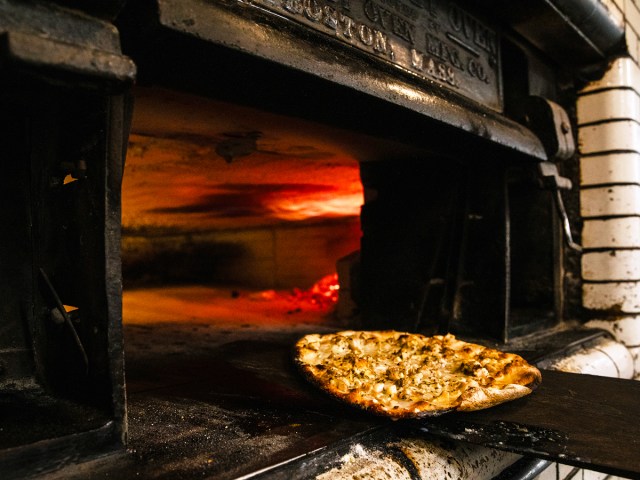
The first thing to know about New Haven pizza is how to get the name right. You’re in Connecticut now, and the locals refer to it as “apizza.” This version has its roots in the traditional Neapolitan style, like New York-style pizza, but that’s where the similarity ends.
New Haven pizza has a chewy crust, thanks to a dough that is allowed to ferment for a longer period of time (often overnight). It is oblong in shape and cooked in a coal-fired oven, which gives it a charred look and taste. A popular local topping is clams with a white sauce, although you’ll also find the standard meat, cheese, and tomato pies. But to really sound like a local, you want to order it “mootz” (with mozzarella).
St. Louis

Many associate St. Louis with barbecue rather than pizza, but the city is indeed home to a distinct pizza style. And it’s made for sharing with a group of friends — some even describe it as a giant nacho rather than a pizza.
There are quite a few similarities. For starters, there’s the base, which is thin and extra crispy. Toppings include a tomato sauce that has a hint of sweetness and a cheese blend known as provel (provolone, Swiss, and cheddar). The toppings go all the way to the edge, and it’s cut not into wedges but squares. St. Louis purists also insist that any toppings must be sliced instead of diced.
New York

In 1905, Gennaro Lombardi opened what is widely considered the first pizzeria in the United States, although some historians believe immigrants were making and selling pizza as early as the 1880s. Using the pizza skills he had learned in Naples, Lombardi’s store in Little Italy was instrumental in defining what we now know and love as New York pizza.
New York pizza is a variation of the traditional Neapolitan style, with a thin, hand-tossed crust, a light amount of sauce, and a generous portion of cheese. New York-style pizza is often sold by the large triangular slice, and the main topping is typically just cheese, although pepperoni may be added too. If you want to enjoy your slice like a true New Yorker, fold it in half before digging in.
Chicago
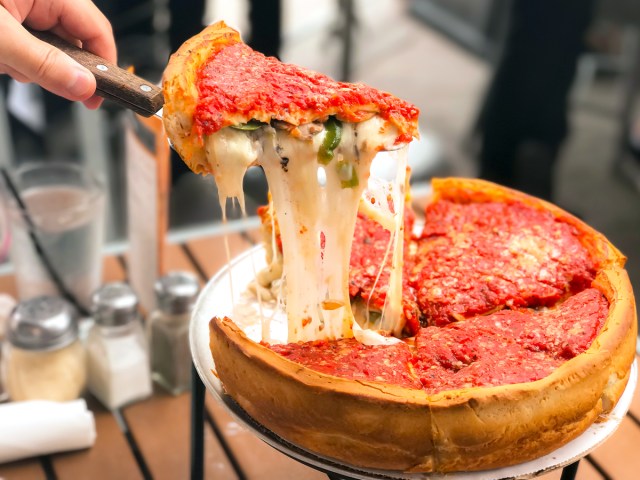
Grab a knife and fork, because there’s no eating Chicago-style deep dish with your hands. Chicago’s beloved pizza is a rich pie baked in a round skillet more similar to a cake pan and filled with thick layers of meat, sauce, and cheese. It is thought to date to 1943, when Ike Sewell and Ric Ricardo opened Pizzeria Uno in the River North neighborhood.
Not content with redefining pizza through deep dish, Chicago also claims credit for inventing stuffed pizza in 1974. This is similar to a deep dish but even deeper and with more cheese. Then there’s tavern-style Chicago pizza, which many locals prefer — thin crust, cut into squares, eaten by hand with your beer at the bar. In other words, you’re likely to find whatever pizza you prefer in the Windy City.
Detroit
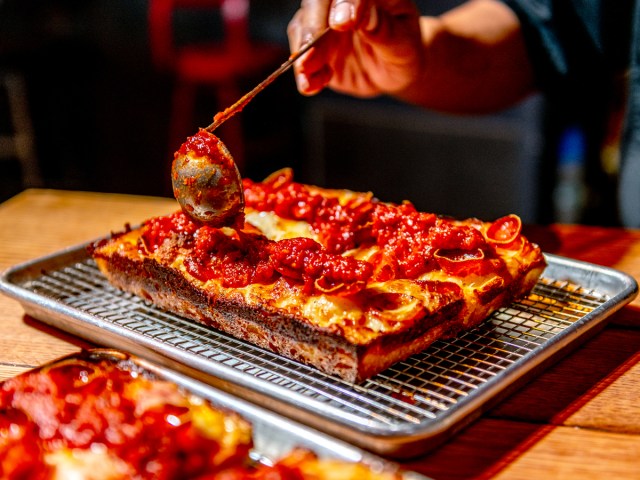
This rectangular pie is cooked in a steel pan, which, according to local legend, was originally an auto parts pan. As the story goes, troops were returning home from Europe after World War II and craving the pizza they had eaten in Italy. Pizzeria owner Gus Guerra borrowed some pans from a friend who had been working in an auto plant, and Detroit-style pizza was born. The crust is thick but surprisingly light. For extra perfection, the pizza is baked twice with the sauce added last to prevent sogginess. Top it with pepperoni, melty brick cheese, and tomato sauce, and you have perfection in a pan.
Philadelphia
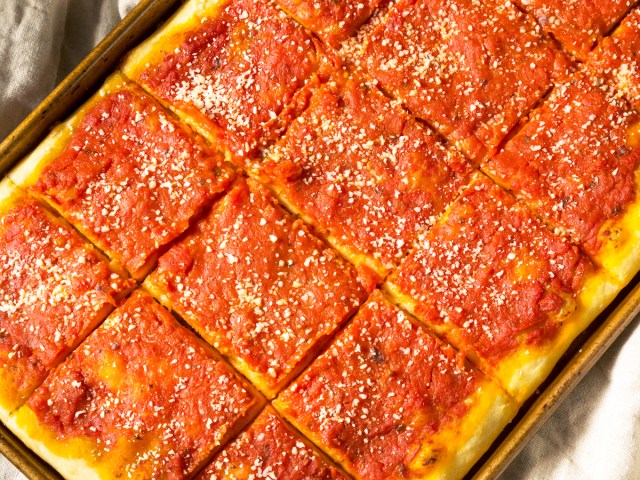
Philadelphia-style pizza, or tomato pie as the locals call it, consists of a thick crust covered in tomato sauce and served in squares. You can add cheese if you like, but it’s not a common topping in Philly. The cheese-free style likely originated in Sicily and was introduced to the city via an influx of immigrants at the turn of the 20th century. Traditionally, tomatoes were more plentiful than dairy cows in Sicily, and other toppings such as anchovies, onions, and oregano were often added to square pizzas. Don’t confuse it with the Trenton tomato pie (a thin, round pizza crust with tomato sauce) or a Southern-style tomato pie (an actual pastry pie).
Quad Cities

Situated between St. Louis and Chicago, the Quad Cities of Iowa and Illinois have also made their mark in the pizza world. The first thing you’ll notice about the local pizza is the crust. The addition of brewer’s malt gives it a distinctly nutty flavor. The sauce also has a kick, made with red chili flakes and cayenne pepper. Popular toppings include Canadian bacon and sausage, which is also different here, since the local variety uses fennel in the meat. The pies are finished off with a thick layer of cheese. One last thing makes the Quad Cities style stand out: It is typically cut into strips before serving.
Rhode Island
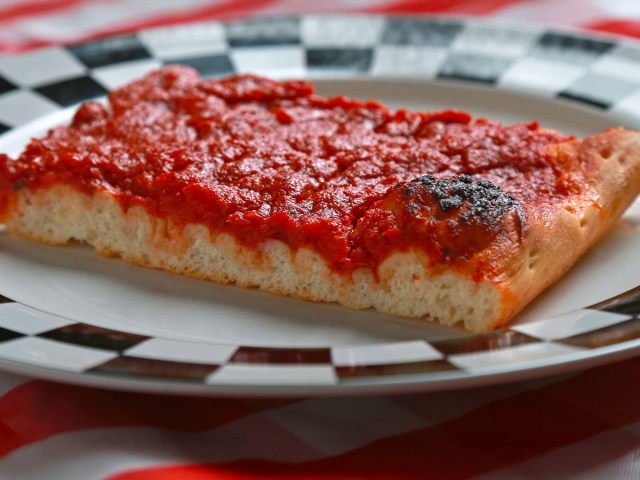
Is it even pizza if it doesn’t include cheese? Philadelphians would say it is, and Rhode Islanders would agree. You’ll just have to find this pizza at a local bakery instead of a pizzeria. Since the early 1900s, Italian bakeries have served strips of focaccia bread topped with tomato sauce, known as “bakery pizza” or simply “red strips.” Bakery pizza is usually served at room temperature as a snack and can be left on the tray for days. It might sound unusual to those outside of Rhode Island, but it’s definitely a staple of the Ocean State.
Ohio Valley

This style of pizza takes its name from the Ohio Valley (which encompasses parts of Ohio, Indiana, West Virginia, Pennsylvania, and Kentucky), but even there, this pizza is not particularly widespread. Ohio Valley-style pizza is different from any other style on this list because the toppings are added after the dough comes out of the oven. Stewed tomatoes are used instead of sauce and may be added before or after cooking. When it comes to toppings, you have plenty of the usual options – meat, veggies, lots of cheese. However, they are all added cold, after the base is taken out of the oven. The theory behind it is that the toppings will cook perfectly from the steam in the box.
More from our network
Daily Passport is part of Inbox Studio, which publishes content that uplifts, informs, and inspires.























